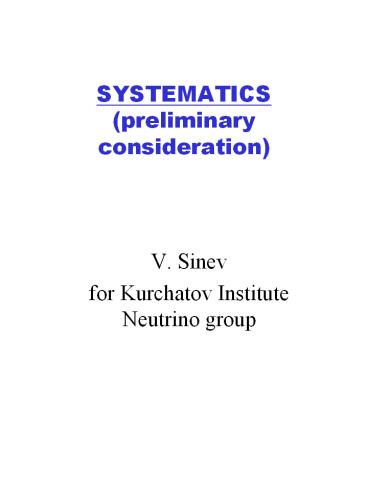SYSTEMATICS (preliminary consideration) - PowerPoint PPT Presentation
1 / 16
Title:
SYSTEMATICS (preliminary consideration)
Description:
SYSTEMATICS (preliminary consideration) V. Sinev. for ... Common consideration. If the detectors, far and near, are absolutely identical, the ratio of two ... – PowerPoint PPT presentation
Number of Views:36
Avg rating:3.0/5.0
Title: SYSTEMATICS (preliminary consideration)
1
SYSTEMATICS (preliminary consideration)
- V. Sinev
- for Kurchatov Institute Neutrino group
2
Common consideration
- If the detectors, far and near, are
absolutely identical, the ratio of two measured
positron spectra Sfar and Snear is energy
independent - SFar/SNear 1 in no-oscillation case,
- normalization equal number of events
- Detector differences can mimic or hide
- oscillations
- Following deviations from detectors identity
have been studied - Different energy resolutions ?Far, ?Near
- Different edge effects (positron annihilation
quanta escape) due to different detector volumes
VFar and VNear. - Different light collection due to difference in
the light absorption lengths ?(440 nm)
3
Sfar/Snear for different energy resolutions
Expected ratio for sin22q130.02, Dm2 2.5?10-3
eV2
Positron visible energy, MeV
4
Sfar/Snear versus Detector volume ratio
Vfar/Vnear
Expected ratio for sin22q130.02, Dm2 2.5?10-3
eV2
V11.2V2
V11.15V2
V11.1V2
Positron visible energy, MeV
5
Light collection vs source position r and light
attenuation length l (440 nm)
Transparency
Light collection from the centre
Light source position, m
6
Sfar/Snear for different attenuation lengths
lfar, lnear
Expected ratio for sin22q130.02, Dm2 2.5?10-3
eV2
Positron visible energy, MeV
7
Neutron detection efficiency vs neutron capture
point
Distance from the centre, m
8
Two gammas absorbed energy versus the point of
positron annihilation
Distance from the centre, m
9
OTHER OPTIONS
The Kr2Det scheme with two 50 ton detectors at
100 and 1000 meters uses available underground
rooms and does not require digging new special
caverns. The oscillation signal could be
increased (1) with the far detector at about
1500 m and (2) in a 3 detector scheme one
near and two far detectors at 1400 and 2700
m. This increase will require larger volume
detectors, deeper detector positions and digging
new under-ground halls.
10
Sfar/Snear at different detector positions
Dm2 2.5?10-3 eV2
1.01 1 0.99
1000/100
1.01 1 0.99
1900/100
0 1 2 3 4 5
6 7 8
Visible energy, MeV
11
1.01 1 0.99
1600/900
900/100
1600/100
1.01 1 0.99
2600/1300
1300/100
2600/100
1.01 1 0.99
3600/1800
3600/100
1800/100
0 1 2 3 4
5 6 7 8
Visible energy, MeV
12
Possible experimental result for ratio at
Krasnoyarsk
13
Conclusion
- We estimated some effects which can influence the
ratio to mimic effect of oscillation - Kr2Det uses available underground halls for far
(1000m) and near (115m) - 50-ton detectors
- The oscillation signal could be somewhat
increased with the Far detector at 1400-1900 m
or with two far detectors at 1300 and 2600 m - This however would require digging new caverns
and using detectors of larger target masses
14
Letter of IntentionI.R.Barabanov,
L.B.Bezrukov, V.I.Gurentsov,V.N.Kornoukhov,
E.A.YanovichInstitute for Nuclear Research of
RAS(Moscow, Russia)N.A.Danilov, G.V.Korpusov,
Yu.S.KrylovInstitute of Physical Chemistry of
RAS(Moscow, Russia)
Development of a recipe and production of
components for a liquid scintillator doped with
Gd for K2Det or Kashiwazaki experiment.
15
1. Development of test batches of Gd-compound for
a liquid scintillator. Based on experience in
the framework of LENS Collaboration on the
development of Yb-loaded scintillator with
characteristics LY 60 of BC 505 (8 of
Yb), L1/2 (430 nm) 2.5 m (8 of Yb),
when c dec. we propose to develop and
synthesized Gd-loaded LS replacing in our
Yb-Carboxylate compound Yb by Gd because of their
common chemical properties (even more difficult
for Yb). M 2 x 150 kg (0,3 of Gd) The
procedure is just simple blending Gd-compound
solvent. 2. Production, purification and
certifi-cation of an effective primary
fluorescent additive (fluor) BPO,
24-biphenyl5-phenyl oxazole. Light Yield of
BPO is 50 more than LY of PPO.
M 2 x 100 kg Development of new fluor
with maximum emission in 430-440 nm
16
- 3. Delivery of organic base (a solvent) for LS
with a high flash point ( 80oC). - M 100 t
- Light output 80 of Whitespirit
- Composition H/C 1.8
- Transparency gt10 m
- Radio purity is low but should be investigated
- Chemical activity - weak
- If LS has HC 2 (for example, Palo
- Verde and CHOOZ experiment)
- Then for Gd 0 (100 captured
- probabilities with E 2.2 MeV)
- ? 180 ?sec
- for Gd 0.1 (86 captured probabilities with E
8 MeV, well above the natural radioactivity) - ? 32 ? 2 ?sec































